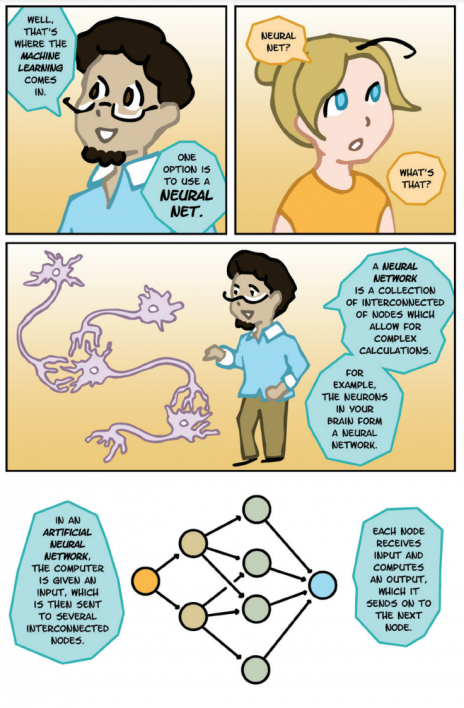ASU alum publishes graphic novel on computer generated images, machine learning

Cover image from "Creating with Code: A Fun Exploration of Computer-Generated Images and Machine Learning."
Jennifer Weiler, an Arizona State University media arts and sciences postdoctoral alumna and current faculty associate, is releasing a comic book this summer that teaches users how to use code to make computer-generated images.
Weiler, who was influenced by her work at ASU as a student in the School of Arts, Media and Engineering, has been working intensely over the last year to create and publish her first comic book, “Creating with Code: A Fun Exploration of Computer-Generated Images and Machine Learning.” She said she made the comic to educate people about how to effectively utilize coding to construct stylistic computer-generated images and apply methodologies of machine learning in the process.
Weiler designed “Creating with Code” in a manner that focuses on learning through visual narration and imagery in a fun way. She plans to release it in digital format on Amazon on June 15, with a print release planned in the next few months.
Question: Can you explain a bit more about the work during your PhD that helped influence this book?
Answer: While pursuing my doctorate in media arts and sciences, I spent a lot of time exploring different ways to create images using computer programming. Essentially, by writing code, it’s possible to give the computer a set of instructions that create different types of images. I have continued to expand my knowledge since graduation, and I have focused on machine learning (computer algorithms that can improve through experience) and how it can be used to generate images. Learning about new approaches and technology is something I enjoy immensely, and I want to introduce more people to these topics.
Q: Would you be able to provide a short description about this comic?
A: “Creating with Code: A Fun Exploration of Computer-Generated Images and Machine Learning” provides a comprehensive introduction to generating artistic images using the latest computer programming techniques. It explores the mechanisms, advantages and limitations of emerging technology. I avoided just creating a list of coding examples because I don’t want the book to be a how-to follow guide. Rather, I wanted to explain the underlying concepts and approaches that allow a series of instructions to create images, as well as some of the challenges that may be faced when trying to get the results you want.
Q: What made you want to create a graphic novel rather than a standard book?
A: The material covered in this book is all about images: what kind of images can be generated and what the results can look like. And, to me, it was obvious that kind of information would best be conveyed in a primarily visual medium. In addition, I’m a big believer in conveying information in an entertaining and efficient way. I feel it would be a disservice to the audience to spend paragraphs trying to explain a concept that can be immediately understood with a sentence and an image.

Excerpt from Weiler's comic.
Q: How long did it take you to create the comic?
A: I first had the idea to create “Creating with Code” back in the summer of 2020. Like many of us, I was spending a lot of time at home and wanted to focus on something fun and productive. Writing and drawing took about five months, but honestly a lot of time before that went into deciding what I wanted to talk about, because there is so much material in this field that it was hard to narrow it down.
Q: What is your hope with this comic book?
A: I want to introduce the concept of generating images with computer programming to people who otherwise wouldn’t have given this topic another thought, and to present it in a way that is not overly technical and won’t require a lot of time to understand. I find this field super fascinating, and I want to share that excitement and promise with as many people as possible.
Back when I was in high school, hardly anyone was learning about computer programming. I can’t help but wonder if media like this could help drive enthusiastic new students into technology-focused creative fields when entering into college and beyond.
Q: Do you have any other future comic books in mind?
A: I’ve absolutely been thinking about what other topics I would like to write about. Art and technology used in makerspaces — another area I explored in my PhD work — comes to mind, but I haven’t made any decisions yet!
Q: Is there any additional information you would like to share?
A: I will be releasing “Creating with Code” in digital format on Amazon on June 15, with a print release planned in the next few months. For anyone interested in updates, I have a mailing list you can join by reaching out to me at orangelooppress@gmail.com. I would be delighted to hear what people think of the book!
More Science and technology

ASU-led space telescope is ready to fly
The Star Planet Activity Research CubeSat, or SPARCS, a small space telescope that will monitor the flares and sunspot activity…

ASU at the heart of the state's revitalized microelectronics industry
A stronger local economy, more reliable technology, and a future where our computers and devices do the impossible: that’s the…

Breakthrough copper alloy achieves unprecedented high-temperature performance
A team of researchers from Arizona State University, the U.S. Army Research Laboratory, Lehigh University and Louisiana State…

